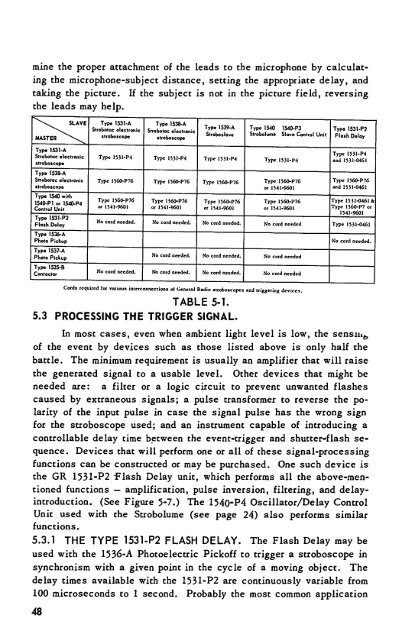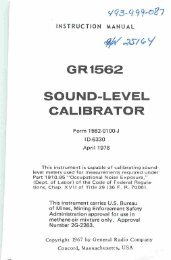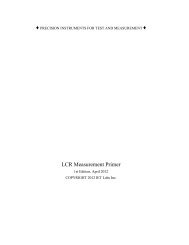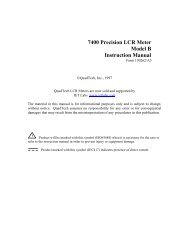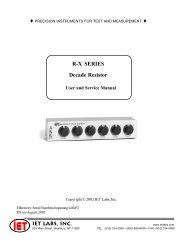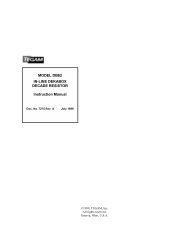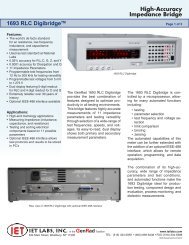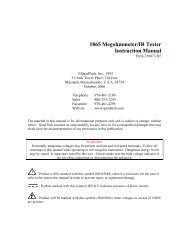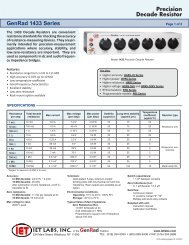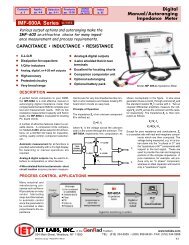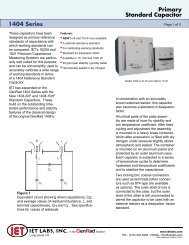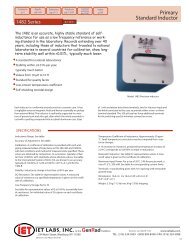Handbook of High Speed Photography - IET Labs, Inc.
Handbook of High Speed Photography - IET Labs, Inc.
Handbook of High Speed Photography - IET Labs, Inc.
You also want an ePaper? Increase the reach of your titles
YUMPU automatically turns print PDFs into web optimized ePapers that Google loves.
mine the proper attachment <strong>of</strong> the leads to the microphone by calculat<br />
ing the microphone-subject distance, setting the appropriate delay, and<br />
taking the picture. If the subject is not in the picture field, reversing<br />
the leads may help.<br />
""•"v.<br />
MASTER<br />
SLAVE<br />
N^<br />
Type 1531-A<br />
Strobotac oloctronic<br />
stroboscope<br />
Typo 1538-A<br />
Strobotac oloctronic<br />
stroboscope<br />
Typo 1540 with<br />
1540-P1 or 1540-P4<br />
Control Unit<br />
Typo 1531-P2<br />
Flash Dolay<br />
Typo 1536-A<br />
Photo Pickup<br />
Typo 1537-A<br />
Photo Pickup<br />
Typo 1535-B<br />
Contoctor<br />
Typo 1531-A<br />
Strobotac oloctronic<br />
stroboscope<br />
Typo 1538-A<br />
Strobotac olectronic<br />
stroboscope<br />
Typo 1539-A<br />
Straboslova<br />
Typo 1540 1540-P3<br />
Strobolume Slavo Control Unit<br />
Type 1531-P4 Type 1531-P4 Type 153I-P4 Type 153I-P4<br />
Type 1560-P76 Type I560-P76 Type 1560-P76 Type I560-P76<br />
or 1541-9601<br />
Type 1560-P76<br />
or 1541-9601<br />
Type 1560-P76<br />
or 1541-9601<br />
Type 1560-P76<br />
or 1541-9601<br />
Type 1560-P76<br />
or 1541-9601<br />
Typo 1531-P2<br />
Flash Doloy<br />
Type 1531-P4<br />
and 1531-0461<br />
Type 1560-P76<br />
and 1531-0461<br />
Type 1531-0461 &<br />
Type 1560-P7 or<br />
1541-9601<br />
No cord needed. No cord needed. No cord needed. No cord needed Type 1531-0461<br />
No cord needed. No cord needed. No cord needed<br />
No cord needed. No cord needed. No cord needed. No cord needed<br />
Cords required for various interconnections <strong>of</strong>General Radio stroboscopes and triggering devices.<br />
TABLE 5-1.<br />
5.3 PROCESSING THE TRIGGER SIGNAL.<br />
No cord needed.<br />
In most cases, even when ambient light level is low, the sensing<br />
<strong>of</strong> the event by devices such as those listed above is only half the<br />
battle. The minimum requirement is usually an amplifier that will raise<br />
the generated signal to a usable level. Other devices that might be<br />
needed are: a filter or a logic circuit to prevent unwanted flashes<br />
caused by extraneous signals; a pulse transformer to reverse the po<br />
larity <strong>of</strong> the input pulse in case the signal pulse has the wrong sign<br />
for the stroboscope used; and an instrument capable <strong>of</strong> introducing a<br />
controllable delay time between the event-trigger and shutter-flash se<br />
quence. Devices that will perform one or all <strong>of</strong> these signal-processing<br />
functions can be constructed or may be purchased. One such device is<br />
the GR 1531-P2 Flash Delay unit, which performs all the above-men<br />
tioned functions —amplification, pulse inversion, filtering, and delayintroduction.<br />
(See Figure 5-7.) The 1540-P4 Oscillator/Delay Control<br />
Unit used with the Strobolume (see page 24) also performs similar<br />
functions.<br />
5.3.1 THE TYPE 1531-P2 FLASH DELAY. The Flash Delay may be<br />
used with the 1536-A Photoelectric Pick<strong>of</strong>f to trigger a stroboscope in<br />
synchronism with a given point in the cycle <strong>of</strong> a moving object. The<br />
delay times available with the 1531-P2 are continuously variable from<br />
100 microseconds to 1 second. Probably the most common application<br />
48


